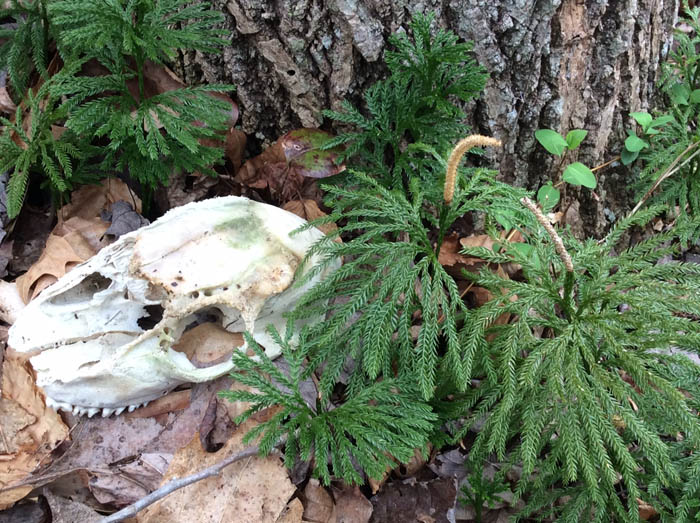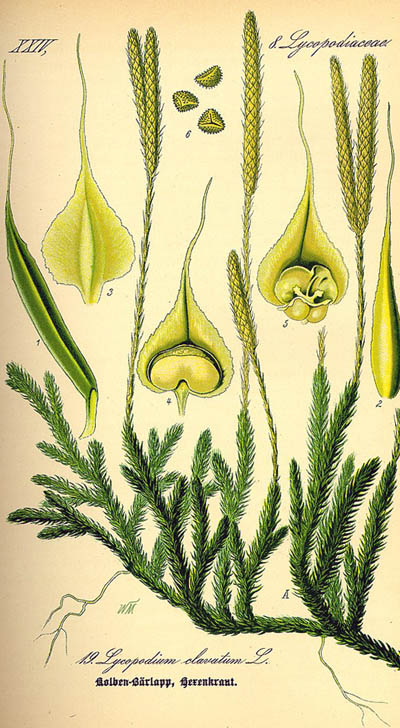
03.21.20 Club Moss “Blossoms”

Keeping my eyes open for interesting new blossoms on my walks I stumbled upon these. (The skull was a surprise as well…not sure of the identification, but maybe a dog since the jaw is so wide?) My first thought was this plant must be sending up some sort of primitive blossom. (Part of the joy of this blog is the opportunity to learn about the complicated botany of our forest.) Well, this plant led to the discovery of a wealth of interesting facts. I had heard our neighbor refer to it as “Running Cedar,” so this was a good place to begin. Running Cedar, Lycompodium clavatum or digitatum or hickeyi depending on what you are reading, is remarkable, first, because it is rather endangered. Mountain people have often collected this plant to use as holiday greenery because of its similarity to cedar. This has been a problem because it is a VERY SLOW GROWING plant taking decades to establish itself and then only with the help of just the right soil organisms which live symbiotically with the roots. But this is not a coniferous plant at all! This is a club moss, an ancient plant form related to ferns which has no blossoms, instead propagating by spores. The golden candle-like extensions shown here are actually left over from last summer. They are the spore-carrying shoots of the plant called strobili, the actually spore-producing portions are known as sporangia. The club-like nature of these strobili and sporangia gives this plant its name, Club Moss. It’s Latin genus name Lycopodium actually means “wolf’s foot.” (I have yet to discover the explanation for this suggestive description.) As for a species name I saw the plant referred to as both clavatum, as in the illustration here and as digitatum. I also found a variety known as hickeyi whose picture on a website looks just like this one. It is commonly called “Pennsylvania Club Moss.” There are several very interesting traditional uses of club moss beyond use as ornamental seasonal garlands. It turns out that the spores produced by these club structures create a very fine powder rich in oil. First peoples of these forests used this dust to create pyrotechnic affects as it bursts into flame with an explosive brightness when lit. It was even once used as photo flash powder and for fire works. The plant is also known to contain just the right chemical combinations to work as a successful mordant when dying textiles with certain dyes. What I thought was a primitive flower turns out to be a treasure store of great value!
 Plate illustrating Lycopodium clavatum from Otto Wilhelm Thomé’s Flora von Deutschland, Osterreich und der Schweiz, 1885. Courtesy of Wikipedia.
Plate illustrating Lycopodium clavatum from Otto Wilhelm Thomé’s Flora von Deutschland, Osterreich und der Schweiz, 1885. Courtesy of Wikipedia.
 Josef Beery
Josef Beery Plate illustrating Lycopodium clavatum from Otto Wilhelm Thomé’s Flora von Deutschland, Osterreich und der Schweiz, 1885. Courtesy of Wikipedia.
Plate illustrating Lycopodium clavatum from Otto Wilhelm Thomé’s Flora von Deutschland, Osterreich und der Schweiz, 1885. Courtesy of Wikipedia.